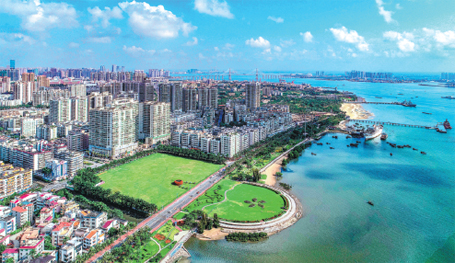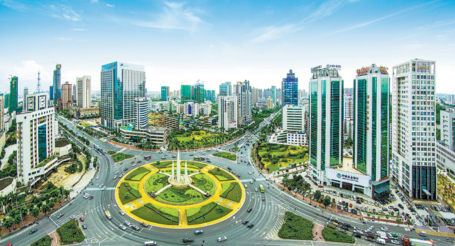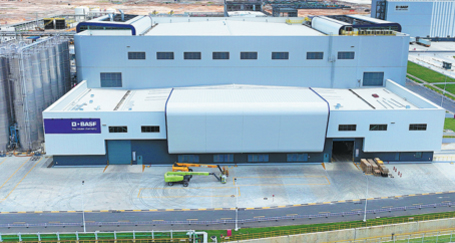Industrial park a model for green development
Expansion project in Donghai helps to build a world-class low-carbon, circular area in Zhanjiang
Steel and chemical industries are easily associated with pollution, but an island industrial park in the city of Zhanjiang in South China's Guangdong province loaded with manufacturing heavyweights of the two industries has become a model for green, low-carbon and circular development.
Donghai Island, the largest island for industrial development in Guangdong, is the major industrial base of the Zhanjiang Economic and Technological Development Zone and is home to three mega industrial projects each involving investment surpassing $10 billion.
Baosteel, China's leading steelmaker, and China Petroleum &Chemical Corporation or Sinopec, the country's leading energy and chemical company, have set up subsidiaries on the island and have continuously invested there over the past decade.
BASF, the German chemical giant, inaugurated the operation of the first plant of its new Verbund site on the island in September, its largest single investment in China with funding surpassing 10 billion euros ($9.88 billion).

The Zhanjiang Economic and Technological Development Zone is building itself into a better area for working, doing business, living and traveling. PENG ZHENQIANG/FOR CHINA DAILY
The three industrial leaders, along with dozens of other significant players in the two industrial chains, make the island one of the first industrial sites in the country with both steel and chemical investments.
Having implemented the idea of recycling for a dozen years, ecologic and low-carbon elements are as ever highlighted in the new round of development, according to the administrative committee of the development zone.
The administrative committee is expanding the industrial park on the island. The expansion follows the ecology-oriented development model advocated by the Ministry of Ecology and Environment, featuring both industrial development and ecological improvement by integrating the development of a large area of mangrove reserve.
When the expansion is completed, the industrial park is expected to become China's largest green and low-carbon industrial demonstration zone, officials with the zone's administrative committee said.
The Zhanjiang Economic and Technological Development Zone began to focus on recycling economy development in 2010 and the industrial park on the island became one of the first batch of circular industrial parks in Guangdong province in 2011.
Recycling practices have already been implemented by local industry players, especially those representing the two leading industries of steel and chemicals ever since.

Hosting a number of operations funded by renowned Chinese and international businesses, the Zhanjiang Economic and Technological Development Zone is a powerful engine for Zhanjiang's economy. XIAO GUANGZHOU/FOR CHINA DAILY
For example, the waste treatment and reuse system has been set up by the companies on the island, shaping a closed loop from raw materials supply to production wastes recycling and reuse and back to production again.
As a result, the utilization efficiency of the main resources, the recycling rate of the solid wastes and water utilization efficiency have been improved markedly, while pollutant discharges have been cut dramatically, according to the administrative committee.
On the production side, the recycling systems of steel and chemical industries have already formed a connected loop to benefit both sides.
The production facility of Baosteel on the island provides hydrogen, nitrogen and oxygen to the Zhongke (Guangdong) Refinery & Petrochemical, a subsidiary of Sinopec, to support its production.
The Baosteel facility achieved a revenue of 128 million yuan in 2021 by supplying a total of 257 million cubic meters of hydrogen, nitrogen and oxygen.
Zhongke also offers steam, desalted water, instrument air and nitrogen to other enterprises in the industrial park.
By sharing resources, the enterprises, especially smaller ones, have been freed from building similar facilities of their own, thus slashing operational costs substantially, the officials said.
Zhongke also transfers production materials including carbon-5, carbon-9, pyrolysis tar oil, carbon dioxide and ethylene oxide to the neighboring downstream chemical companies via pipelines. In this way, the materials supply could be safe and convenient, providing guarantees to the production at the downstream of the industrial chain, cutting long-distance transportation costs.

One of the plants of BASF's new Verbund site in Zhanjiang. CHINA DAILY
In the future, the zone's administrative committee plans to expand the integration of industries in the island industrial park from supply of resources and materials to another three major areas — industrial chain design, environmental protection and management services.
Such integration will take place in the industries of papermaking and textiles as well. The linkage between different companies and different industrial chains to promote recycling will also be highlighted.
All the efforts aim to build a world-class green, low-carbon industrial park with an effective recycling system on the island, the officials said.
The endeavors and green practices of the island industrial park have helped to enhance its appeal to investors from home and abroad. Twelve of the Fortune Global 500 corporations have invested in the island.
This year, a total of 30 key projects are either under construction or planned to begin construction, with a total investment reaching 25.82 billion yuan.
In 2021, the output of the petrochemical industrial cluster on the island hit 116.3 billion yuan, becoming the first industrial cluster in Zhanjiang that surpassed the benchmark of 100 billion yuan, official data showed.
The GDP of the development zone is projected to exceed 100 billion yuan by the end of 2025, accounting for nearly one-fourth of Zhanjiang's total, according to the government's plan.



 Print
Print Mail
Mail

